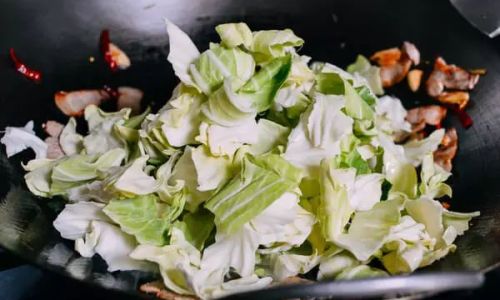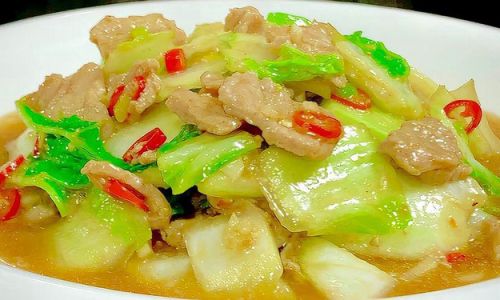Stir-fried cabbage with meat, a humble yet deeply satisfying dish, is a cornerstone of home-cooked meals across Asia and beyond. Its simplicity belies its potential for complexity—a balance of textures, flavors, and aromas that can elevate it from a mere side dish to a star attraction. Whether you’re a novice cook or a seasoned home chef, mastering this recipe requires attention to detail, an understanding of ingredients, and a willingness to experiment. This article will delve into the nuances of crafting the perfect stir-fried cabbage with meat, exploring everything from ingredient selection to advanced techniques that will make your dish unforgettable.
The Foundations: Ingredients and Tools
Before lighting the stove, it’s essential to gather the right components. The beauty of stir-fried cabbage with meat lies in its adaptability, but certain elements are non-negotiable for achieving excellence.
Cabbage Selection
The star of the dish, cabbage comes in various forms—Napa, green, red, or Savoy. Each variety offers a distinct texture and flavor. Napa cabbage, with its tender leaves and mild sweetness, is ideal for stir-fries due to its quick cooking time and ability to absorb flavors. Green cabbage, while crunchier, requires slightly longer cooking to soften. Red cabbage adds a vibrant hue and a subtle earthiness, while Savoy offers a delicate, ruffled texture. Choose a cabbage that feels heavy for its size, with crisp, unblemished leaves.

Meat Choices
Pork is the traditional choice for this dish, particularly pork belly or shoulder, as its fat content adds richness. However, chicken thigh, beef flank, or even shrimp can be substituted. The key is to slice the meat thinly against the grain to ensure tenderness. Marinating the meat in a mixture of soy sauce, rice wine, and cornstarch before cooking will enhance its flavor and texture.
Aromatics and Seasonings
Garlic, ginger, and scallions form the aromatic backbone of the dish. Fresh garlic, minced or sliced, imparts a pungent kick, while ginger adds a warm, citrusy note. Scallions, added at the end, provide a fresh, oniony finish. For seasoning, soy sauce (light or dark), oyster sauce, and a touch of sesame oil are classic. Optional additions like chili paste, black vinegar, or a pinch of sugar can elevate the dish’s complexity.
Tools of the Trade
A well-seasoned carbon steel wok is ideal for stir-frying, as it distributes heat evenly and allows for high-temperature cooking. However, a large skillet or cast-iron pan can suffice. Ensure your cooking vessel is scorching hot before adding oil to prevent sticking. A sharp chef’s knife and a sturdy cutting board are also essential for precise ingredient preparation.
Preparation: The Key to Perfect Execution
Stir-frying is a rapid cooking method, so mise en place is critical. Preparing all ingredients in advance ensures nothing burns or overcooks.
Prepping the Cabbage
Remove any wilted outer leaves and rinse the cabbage under cold water. Pat it dry thoroughly to prevent excess moisture from steaming the dish instead of stir-frying. For Napa cabbage, separate the leaves and slice them into 2-inch strips. For green or red cabbage, core it and shred it into thin ribbons.
Slicing the Meat
Partially freeze the meat for 20–30 minutes to make slicing easier. Aim for ⅛-inch-thick slices, cutting against the grain to shorten the muscle fibers. Marinate the meat in a mixture of 1 tablespoon soy sauce, 1 teaspoon cornstarch, and 1 teaspoon oil for 15–30 minutes. This tenderizes the meat and creates a protective coating.

Mise en Place
Mince 4 garlic cloves and grate a 1-inch piece of ginger. Slice 3 scallions into 1-inch segments, separating the white and green parts. Prepare a small bowl of seasoning sauce: 2 tablespoons soy sauce, 1 tablespoon oyster sauce, 1 teaspoon sugar, and a splash of Shaoxing wine (optional). Have 1 tablespoon of sesame oil and 1 teaspoon of cornstarch mixed with 2 tablespoons of water on standby.
Cooking Technique: Mastering the Stir-Fry
Stir-frying is as much an art as a science. The goal is to cook ingredients quickly over high heat, preserving their texture and flavor while caramelizing their edges for depth.
Heating the Wok
Place your wok over high heat and let it preheat for 2–3 minutes until a drop of water evaporates instantly. Add 2 tablespoons of oil (peanut, vegetable, or canola) and swirl to coat the surface. The oil should shimmer but not smoke.
Searing the Aromatics
Add the garlic and ginger to the wok, stirring constantly for 10–15 seconds until fragrant. Avoid letting them burn, as this will impart bitterness. Immediately add the marinated meat, spreading it in a single layer. Let it sear undisturbed for 30 seconds to develop a golden crust, then stir-fry for 2–3 minutes until cooked through. Remove the meat from the wok and set it aside.
Cooking the Cabbage
Add another tablespoon of oil to the wok if needed. Toss in the cabbage and white parts of the scallions. Stir-fry vigorously for 3–4 minutes, using a spatula to lift and turn the cabbage to ensure even cooking. Napa cabbage will wilt quickly, while green cabbage may require an additional minute. Season with a pinch of salt to draw out moisture and accelerate cooking.
Combining Ingredients
Return the meat to the wok and pour in the seasoning sauce. Stir-fry for 1–2 minutes, allowing the flavors to meld. For a glossy finish, drizzle in the cornstarch slurry while stirring. The sauce should thicken slightly, coating the ingredients without becoming gloppy.

Final Touches
Remove the wok from heat and stir in the sesame oil and green scallion parts. The residual heat will gently cook the scallions, preserving their vibrant color. Taste and adjust seasoning with extra soy sauce or a splash of vinegar if desired.
Advanced Tips for Culinary Excellence
Achieving Perfect Texture
Overcooking cabbage turns it mushy, while undercooking leaves it fibrous. Test for doneness by piercing a leaf with a knife—it should offer slight resistance but yield easily. For added crunch, blanch the cabbage in boiling water for 30 seconds before stir-frying.
Balancing Flavors
The dish should strike a harmony between salty, sweet, and umami. If the sauce is too one-dimensional, introduce acidity with a splash of rice vinegar or brightness with a pinch of citrus zest. A small knob of butter stirred in at the end adds richness and gloss.
Enhancing Aroma
For an aromatic boost, add a star anise or a cinnamon stick to the wok during the initial searing of aromatics. Remove these spices before adding the cabbage to avoid overpowering the dish.
Vegetarian Variations
Replace meat with crumbled tofu or tempeh, marinated similarly for texture. Mushrooms, such as shiitake or oyster, add meaty depth.
Troubleshooting Common Pitfalls
Soggy Cabbage
Excess moisture is the enemy of stir-fries. Ensure the cabbage is thoroughly dried after washing. If blanching, pat it dry afterward. Cooking over high heat also helps evaporate moisture quickly.

Tough Meat
Slicing meat against the grain and marinating it are crucial. Avoid overcrowding the wok, as this lowers the temperature and causes the meat to steam instead of sear. Cook in batches if necessary.
Bland Flavor
Layer flavors by toasting whole spices, using aromatic oils, or adding a splash of fish sauce. Garnish with fresh herbs like cilantro or basil for a pop of freshness.
Cultural Context and Regional Variations
Stir-fried cabbage with meat transcends borders, with each region adding its own twist. In China, Sichuan cooks might incorporate doubanjiang (chili bean paste) and Sichuan peppercorns for a麻辣 (má là) kick. Korean versions often include gochujang and sesame seeds, while Japanese adaptations might use miso and bonito flakes. Experiment with these regional influences to create a dish that reflects your palate.
Serving Suggestions and Pairings
This dish pairs beautifully with steamed jasmine rice, noodles, or congee. For a complete meal, serve it alongside a clear broth soup and a plate of pickled vegetables. Leftovers make excellent fillings for spring rolls or dumplings.
Conclusion: The Joy of Simplicity
Stir-fried cabbage with meat is a testament to the beauty of uncomplicated cooking. By focusing on quality ingredients, precise technique, and a willingness to adapt, even the most modest components can become a feast for the senses. Whether you’re feeding a family or cooking solo, mastering this dish offers a gateway to the endless possibilities of stir-frying. So grab your wok, sharpen your knife, and let the sizzle of the pan guide you to culinary mastery.






0 comments